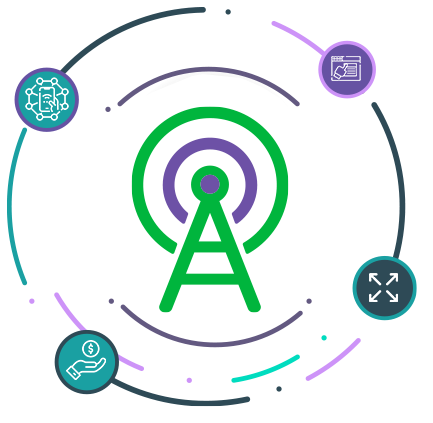In the evolving world of telecommunications, speed, scalability, and reliability are non-negotiable. As operators rush to keep up with rising demand, legacy infrastructure like SS7, while reliable, can be restrictive. This is where the SIGTRAN gateway comes into play — a silent powerhouse transforming the way telecom networks function behind the scenes.
A SIGTRAN GW isn’t just a simple bridge between networks. It’s a highly strategic component that empowers telcos to extend, modernize, and monetize their networks efficiently. Whether you’re looking at cost reduction, service innovation, or network agility, SIGTRAN GWs are the unsung heroes pushing telcos into the future.
At its core, a SIGTRAN GW takes those trusty SS7 signaling messages — the ones that handle call setup, roaming, SMS, and location updates — and transports them over IP. That means you get all the reliability of SS7, without the expensive, inflexible TDM infrastructure dragging you down.
So instead of ripping and replacing your legacy setup, SIGTRAN lets you retrofit it for the IP era. Think of it as breathing new life into your signaling core, without open-heart surgery.
By implementing all of this in software, telcos gain more flexibility, faster rollout times, and lower dependency on expensive proprietary systems. And let’s be real — in today’s market, speed and cost savings aren’t optional.
You get access to subscriber data, routing, and authentication — all without rewriting your network from scratch.
If you’re wondering whether it scales, it does. If you’re wondering whether it’s reliable, it is. If you’re wondering whether it makes business sense, check the ROI.
Moreover, as service providers seek to launch new offerings faster — from mobile payments to identity verification and fraud detection — the need for fast, programmable access to the signaling core becomes essential. SIGTRAN GWs fill this gap perfectly, enabling access to critical functions in the mobile core network while maintaining security and reliability.
With over 27 years of telecom expertise, it’s built to scale with your business, offering full customization, dual API layers for flexible workflows, and seamless integration into your core network. It’s not just a gateway — it’s your edge in a competitive telecom landscape.
So, the next time someone brings up network transformation, don’t start with 5G or AI. Start with signalling. Start with SIGTRAN. When the foundation is flexible, everything else becomes possible. Explore hSenid’s SIGTRAN Gateway solution and start simulating smarter.
A SIGTRAN GW isn’t just a simple bridge between networks. It’s a highly strategic component that empowers telcos to extend, modernize, and monetize their networks efficiently. Whether you’re looking at cost reduction, service innovation, or network agility, SIGTRAN GWs are the unsung heroes pushing telcos into the future.
What Is a SIGTRAN Gateway?
Let’s rewind a bit. SS7, or Signaling System 7, has been the cornerstone of global telecom signaling for decades. It’s responsible for call setup, routing, SMS, roaming, and other crucial services. Traditionally, SS7 operated over expensive TDM (Time Division Multiplexing) networks. But as digital transformation took hold, telcos began searching for more cost-effective, scalable solutions.At its core, a SIGTRAN GW takes those trusty SS7 signaling messages — the ones that handle call setup, roaming, SMS, and location updates — and transports them over IP. That means you get all the reliability of SS7, without the expensive, inflexible TDM infrastructure dragging you down.
So instead of ripping and replacing your legacy setup, SIGTRAN lets you retrofit it for the IP era. Think of it as breathing new life into your signaling core, without open-heart surgery.
The Tech Stack: SIGTRAN’s Secret Sauce
Under the hood, a modern SIGTRAN GW is built on a rock-solid protocol stack:- SCTP: Keeps your message delivery reliable and ordered, even when the network’s having a bad day.
- MTP: Handles the nuts and bolts of routing and delivery, SS7-style.
- SCCP: Adds advanced routing so your messages don’t get lost in translation.
- TCAP: Enables transaction-based magic like prepaid billing and location queries.
- MAP: Manages mobile must-haves — roaming, authentication, location updates, and more.
By implementing all of this in software, telcos gain more flexibility, faster rollout times, and lower dependency on expensive proprietary systems. And let’s be real — in today’s market, speed and cost savings aren’t optional.
Why SIGTRAN GWs Belong in Every Modern Network
1. They Cut Costs Without Cutting Corners
Traditional SS7 gear is painfully expensive and frustratingly rigid. SIGTRAN GWs slash CapEx by letting you run SS7 over standard IP infrastructure. No more TDM trenches, no more overpriced vendor lock-in. By adopting a software-based SIGTRAN stack, like hSenid Mobile’s in-house solution, telcos can avoid third-party licensing fees and proprietary hardware costs.2. Simplified VAS Integration
The telecom industry thrives on value-added services (VAS) such as SMS-based banking, location-based advertising, or mobile number portability services. A SIGTRAN GW simplifies VAS integration by exposing signaling functions as telecom APIs. hSenid Mobile’s solution, for example, supports direct and flow-based API calls, allowing internal applications to trigger SS7 signaling events without diving into low-level protocol details.3. They Scale Without the Suffering
Future-proofing your network isn’t just a buzzword. With a loosely coupled SIGTRAN architecture, you can add new services, like HLR lookups or SMSC integration, without overhauling everything. That’s real agility. And when new use cases pop up? Just plug, configure, and go.4. They Supercharge Service Delivery
APIs are the name of the game. SIGTRAN GWs make it easy to tap into core network functions, like:- SendAuthenticationInfo: Grab authentication vectors for Wi-Fi offloading
- RestoreData: Fetch service and routing profiles from the HLR
- SendRoutingInfoForLCS: Enable location-based experiences
- FindIMSI: Smooth out multi-SIM and MNP scenarios
You get access to subscriber data, routing, and authentication — all without rewriting your network from scratch.
5. Proven in Real-World Deployments
The strength of a SIGTRAN GW lies not just in its architecture but in its reliability. hSenid Mobile’s SIGTRAN GW is already running in live, carrier-grade deployments around the world. We’re talking:- SMSC integration for lightning-fast message delivery
- USSD Gateway pairing for real-time interactions
- Location-based service enablement
- Seamless mobile data offloading
- Clean MNP routing and smart call control
If you’re wondering whether it scales, it does. If you’re wondering whether it’s reliable, it is. If you’re wondering whether it makes business sense, check the ROI.
SIGTRAN and the Future of Telecom Infrastructure
The digital transformation journey in telecom is nowhere near over. With 5G and IoT ramping up, operators are dealing with an explosion in signaling traffic. Instead of investing in bulky, outdated hardware, SIGTRAN GWs offer a streamlined, flexible way to scale up without scaling costs.Moreover, as service providers seek to launch new offerings faster — from mobile payments to identity verification and fraud detection — the need for fast, programmable access to the signaling core becomes essential. SIGTRAN GWs fill this gap perfectly, enabling access to critical functions in the mobile core network while maintaining security and reliability.
Why hSenid Mobile’s SIGTRAN Gateway Is Built Differently
Not all SIGTRAN solutions are created equal. hSenid Mobile’s SIGTRAN gateway is software-based for fast, hassle-free deployment, API-driven for effortless integration, and battle-tested in real-world carrier environments.With over 27 years of telecom expertise, it’s built to scale with your business, offering full customization, dual API layers for flexible workflows, and seamless integration into your core network. It’s not just a gateway — it’s your edge in a competitive telecom landscape.
Final Thoughts
Telecom isn’t just about connectivity anymore. Telecom is no longer just about calls and messages — it’s about ecosystems, experiences, and efficiency. Operators must rethink how they manage and expose their core network capabilities. A SIGTRAN GW is no longer optional — it’s a strategic imperative. The SIGTRAN gateway isn’t just a nice-to-have. It’s the backbone of a modern, API-driven telecom strategy. Quiet. Powerful. Essential.So, the next time someone brings up network transformation, don’t start with 5G or AI. Start with signalling. Start with SIGTRAN. When the foundation is flexible, everything else becomes possible. Explore hSenid’s SIGTRAN Gateway solution and start simulating smarter.








